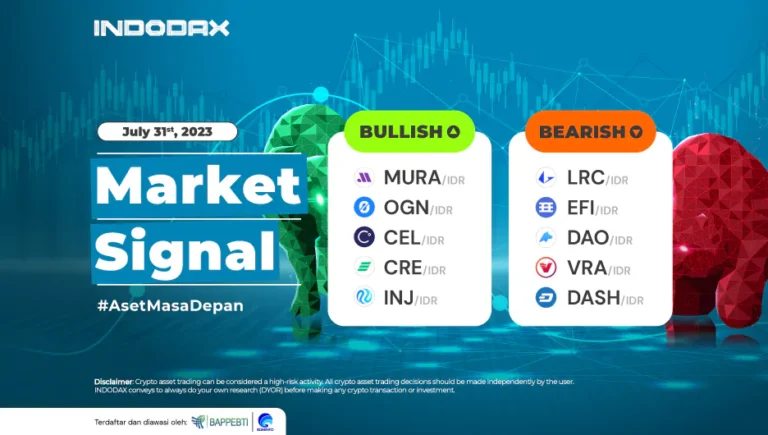One type of transaction that is often carried out in trading stocks and crypto assets is short selling.
Short selling was a hot topic at the beginning of 2020 because the Indonesia Stock Exchange (IDX) banned this transaction.
Short selling is considered quite risky to be carried out by investors and traders. Apart from short selling, another related term is a long position.
So, to better understand what short selling is, what differentiates it from long positions, and the advantages and risks of using a short selling strategy, consider the following review.
Definition of Short Selling and Long Position

You need to know that short selling is an activity or technique of selling commodities in the financial market when an investor or trader sells assets they do not own to gain profit from a decrease in the value of these assets.
In the short-selling process, the investor borrows the asset from another party to sell, then buys the same asset on the market at a lower price to return it to the borrower.
The purpose of short selling is for a transaction to benefit from a decrease in the price of the asset being sold.
The opposite of short selling, a long position is when an investor buys an asset with the hope that the asset’s price will rise so that they can sell it at a higher price and make a profit.
In a long position, investors buy assets to hold them for a certain period.
A long position is a strategy commonly used in long-term investments and is usually carried out by investors who have positive confidence in the assets they buy.
The main objective of a long position is to benefit from the appreciation in the value of the asset in the future.
A simple example regarding short selling and long positions is as follows, namely:
1. Short Selling
Suppose investor A believes that company ABC’s stock is overvalued, and he decides to short-sell.
Investor A borrows 100 shares of ABC stock from a stockbroker and sells them on the open market for $1,000.
After some time, ABC’s stock price fell, as predicted by investor A.
Then, investor A buys back 100 shares of ABC stock for $800 and returns them to the stockbroker.
The difference in the price of $ 200 ($ 1,000 – $ 800) is the profit obtained by investor A from short selling.
2. Long Position
Suppose investor B takes a long position in XYZ company stock and buys 100 shares of XYZ stock for a total of $1,000 because he believes that the company has good prospects and that its share price will rise.
After some time, XYZ’s stock price rose to match investor B’s expectations, and he sold 100 shares of XYZ for a total of $1,500, making a profit of $500 ($1,500 – $1,000).
Advantages and Risks of Short Selling and Long Positions

Understanding the advantages and risks of selling short and long positions is important before deciding to use any of these strategies.
An in-depth understanding of the advantages and risks of short selling and long positions will help to make wiser investment decisions.
Conducting a thorough analysis, considering risk factors, and managing risks carefully when using any of these strategies is important.
Some of the advantages of short selling are as follows:
-
Profit Potential When Prices Drop
In short selling, investors can benefit if the price of the asset being sold shortfalls.
By selling an asset at a high price and buying it back at a lower price, investors can turn the price difference into a profit.
-
Diversify Portfolio
Short selling allows you to diversify an investor’s investment portfolio.
When an investor has a long position on a particular asset, short-selling another asset that is considered overvalued or has the potential to decrease in price can provide protection and reduce the risk of your portfolio.
-
Profiting from a Bearish Market
Short selling provides an opportunity to make a profit when the market is in a bearish trend.
Investors can take advantage of falling asset prices and make profits even when most investors are losing.
-
Protection Instruments (Hedging)
Short selling can be used as an instrument of protection or hedging.
If an investor holds a long position in an asset and anticipates a decline in its price, then selling short in that asset can help protect the portfolio’s value from this decline.
-
Freedom to Take a Sell Position
Short selling allows investors to take short positions in assets that are considered overvalued or have poor prospects.
This allows investors to benefit from price drops and seize opportunities in declining markets.
Meanwhile, some risks of short selling that need to be known are as follows, namely:
-
Unlimited Losses
In short selling, the potential for loss is unlimited. If the price of an asset that the investor short-sold rises, the investor may have to buy back the asset at a higher price than the initial selling price resulting in a significant loss.
-
Fulfillment of Margin Calls
If the price of the asset the investor is selling short increases significantly, the broker may ask the investor to add funds or provide additional collateral (margin call) to meet the investor’s obligations.
The broker can forcibly close your short position if the investor cannot fulfill the margin call.
-
Stock or Crypto Loan Time
In stock or crypto loans, brokers or third parties who provide loans can ask the borrower to return the borrowed shares or crypto at any time.
A loan agreement between the borrower and the lender usually regulates this.
On the other hand, the advantages of long positions are as follows, namely:
-
Long-Term Profit Potential
In a long position, the investor buys an asset with the expectation that it will increase in price.
If the asset increases in value, investors can benefit from the difference between the selling and buying prices.
-
Participation in Economic and Business Growth
Through a long position, investors can benefit from economic and business growth.
When investors have a position in assets related to the growth and performance of the company, they can take advantage of the increase in the value of these assets along with the company’s success and good economic conditions.
-
Getting Dividends and Return on Capital
If an investor has a long position in stocks, he has the potential to get regular dividends from the company.
In addition, investors can get a return on capital through the profit on the sale of shares after a certain period.
-
Access to Voting Rights
Investors can vote at the company’s shareholder meeting in a long position in shares.
It allows investors to participate in the company’s decision-making process and influence the direction of the company through their votes.
However, as with all forms of investment, long positions involve certain risks, including:
-
Potential Losses
If the price of the asset the investor buys goes down, then he is at risk of a loss if you decide to sell it.
Various factors can affect asset values, including market conditions, company performance, and global economic factors.
-
Market Risk
Changes in general market conditions can affect the value of an investor’s assets.
Price fluctuations, market volatility, and changes in economic trends can cause an investor’s assets to fluctuate.
-
Asset Specific Risk
The risks associated with specific assets also need to be considered. For example, suppose an investor has a long position in a certain company’s stock. In that case, the business or industrial risks associated with that company can affect the value of that stock.
-
Financial and Liquidity Risks
There are financial and liquidity risks associated with long positions. The investor should consider his ability to sustain his investment over the long term and deal with situations where he may need to sell assets quickly.
Difference between Long and Short Selling in Crypto and Stocks
Understanding the difference between long and short-selling in cryptocurrencies and stocks is very important because it will influence your investment approach and strategy.
It is important to understand these differences for several reasons, including different investment objectives, different risks, an understanding of the market, investment sustainability, and strategies and analysis.
By understanding the difference between long and short selling in cryptocurrencies and stocks, investors can choose a strategy that suits their investment objectives, manage risk better, and make informed and informed investment decisions.
Here are some differences between long and short selling in crypto and stocks that you need to know, namely:
1. The difference in the way of doing
The main difference between short selling and long positions lies in the steps involved in initiating and closing trades and the objectives of each of these strategies.
In short selling, investors will borrow assets, sell them, and then buy them back at a lower price.
Meanwhile, in a long position, the investor will buy the asset and sell it at a higher price or hold on to it for long-term benefits such as dividends or growth in the asset’s value.
2. The difference in risk and reward
The difference in risk and reward between short and long positions in stocks and cryptocurrencies can vary depending on the characteristics of the market and the asset in question.
Short selling in stocks includes unlimited potential risks and potential margin calls.
Meanwhile, the advantage of short selling in stocks is the opportunity to benefit from declining stock prices and portfolio diversification.
On the other hand, the risks of short-selling crypto include high volatility and low liquidity.
Please note the advantage of short selling in crypto is the opportunity to benefit from volatility as well as the potential to generate profits in both bullish and bearish markets.
Then, the risks and benefits of long positions in stocks and crypto lie in the risk of falling asset prices and the long-term profit potential.
Rules and Regulations regarding Short Selling and Long Positions
Understanding the rules and regulations regarding short selling and long positions is very important because they can affect how investors participate in the market and implement their investment strategies.
In addition, it is important to note that the rules and regulations regarding short-selling and long positions may vary between different countries and markets.
Therefore, it is very important to conduct research and consult with relevant authorities to understand the specific requirements for the jurisdiction the investor wishes to participate in and the market.
Please note that some countries or stock/crypto exchanges have different rules regarding short selling, such as time limits, the amount of assets that can be borrowed, and margin requirements.
1. Time Limit
Some countries or stock/crypto exchanges apply certain time limits for short selling.
For example, some limit short selling only on regular trading days, while others always allow it.
2. Amount of Borrowable Assets
Each country or exchange may have limits regarding the number of assets that can be borrowed for short-selling purposes.
It may depend on the asset’s liquidity and the market’s ability to provide borrowable stock.
3. Margin Requirements
Margin requirements are the number of funds that must be placed by the short-selling party as collateral.
These margin requirements may vary depending on the country or stock/crypto exchange.
Higher margin requirements may be applied to reduce risk and maintain market stability.
Although short selling is legally legal in many countries, some brokers or trading platforms may restrict or impose additional requirements regarding the use of this strategy.
Short selling carries a higher risk than a long position strategy, and some brokers or platforms may want to protect investors or maintain their internal stability.
Therefore, investors need to research and understand the policies and requirements a particular broker or platform applies before using a short-selling strategy.
Strategies for Reducing Risk
Understanding strategies to reduce risk in short-selling stocks and crypto is very important to protect yourself as an investor.
In addition, it should be understood that short selling is a complex and high-risk investment strategy.
Therefore, it is important to gain an in-depth understanding of the asset to be shorted, master market analysis, and have adequate knowledge before engaging in short selling.
Here are some strategies that can be done to reduce the risk of short selling, including:
1. Use stop-loss orders
Using stop-loss orders is one effective strategy for limiting losses on short-selling positions.
A stop-loss order is an instruction given to a broker or trading platform used by an investor to automatically sell a short position if the price of an asset reaches a predetermined level.
Using a stop-loss order, the investor can determine the price level at which he wants to get out of a short position if the asset price increases.
2. Choose a stable stock or crypto
Choosing stable stocks or cryptos can be an effective strategy for reducing risk in short selling.
When short-selling a stable asset, there is less chance of a drastic price movement, reducing the risk of significant losses.
When choosing stocks or Stable crypto, several factors can be considered: strong fundamentals, high liquidity, stable price trends, consistent technical analysis, and portfolio diversification.
3. Check volatility
Checking for volatility is an important strategy for reducing risk in short selling.
It is important to note volatility refers to significant price fluctuations over time.
In the context of short selling, understanding the volatility of an asset can help you identify potential risks and take appropriate steps.
You can use volatility as a strategy to reduce short-selling risk by analyzing volatility, using volatility indicators, considering relative volatility, monitoring important events and news, and using position size wisely.
Making a clear investment plan is an important strategy for reducing risk in short selling.
By having a structured plan, you can make more informed investment decisions and manage risk better.
In addition, setting realistic profit targets is also an important strategy for reducing risk in short selling.
By having realistic profit targets, you can set balanced expectations and avoid excessive greed.
In addition, determining the desired investment period is an important strategy for reducing risk in short selling.
Some things to consider when determining the investment timeframe are fundamental and technical analysis, investment objectives, risk tolerance, volatility periods, trading strategies, and monitoring market conditions.
Conclusion
In conclusion, short selling is an activity or technique of selling commodities in the financial market when an investor or trader sells an asset that he does not actually own to gain profit from a decrease in the asset’s value.
In the short-selling process, the investor borrows the asset from another party to sell, then buys the same asset on the market at a lower price to return it to the borrower.
Meanwhile, a long position is a condition when an investor buys an asset with the hope that the asset’s price will rise so that they can sell it at a higher price and make a profit.
In a long position, investors buy assets intending to hold them for a certain period.
For novice investors, it is important to understand short and long-selling strategies in crypto and stocks before using them.
Some things to consider regarding using short and long-selling strategies in crypto and stocks are education and research, making an investment plan, starting with well-managed capital, understanding risk, and using fundamental and technical analysis.
Disclaimer
It is important to remember that investing in crypto is very risky, and investors can experience significant losses.
Therefore, before deciding to use a short or long-selling strategy in crypto, traders should understand the risks associated with investing in crypto and carefully analyze the assets to be bought or sold.
This is because short selling is an investment strategy that involves high and complex risks.
Besides that, in conducting short selling, several important things need to be considered, including the risk of unlimited losses, time constraints, market volatility, in-depth understanding, and regulations and rules.
Interested in Crypto Investment?
Now you understand short selling in crypto and stocks and the risks.
Furthermore, if you want to make safe, easy crypto investments, try it on INDODAX.
As an initial step, you must download the INDODAX application for Android and IOS users.
After that, you can use the best features in the INDODAX mobile application to start investing in crypto.
Come on, invest now!








